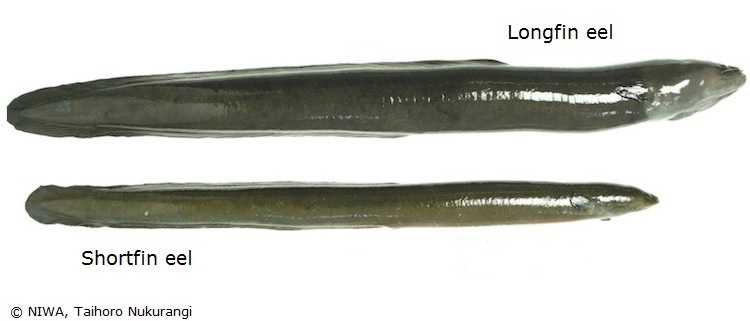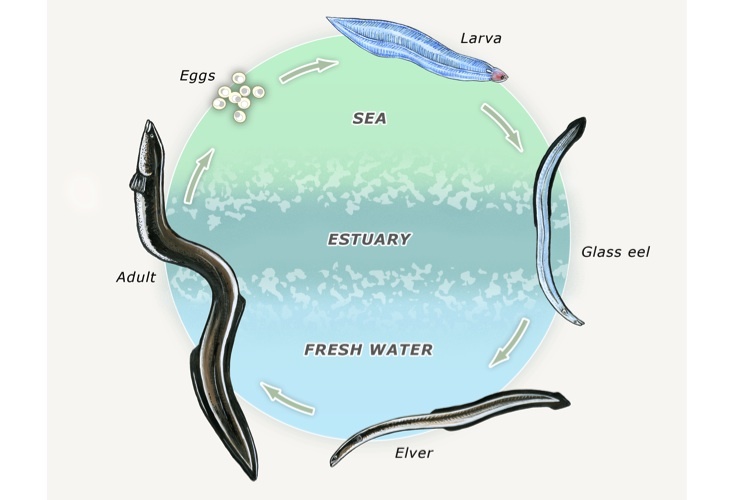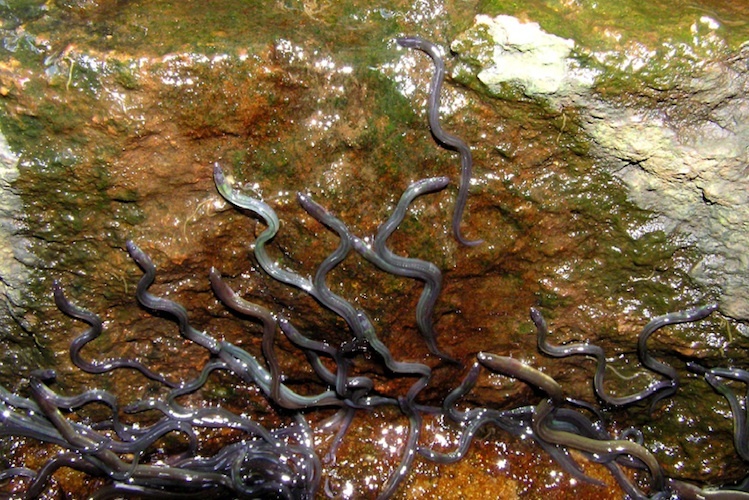The Aotearoa New Zealand longfin eel ❘ tuna (Anguilla dieffenbachii) is New Zealand’s only endemic freshwater eel. Our shortfin eel (Anguilla australis) is also found in Australia and some Pacific Islands. We also have a recently introduced longfin eel from Australia (Anguilla reinhardtii).
Longfin eels can be identified because the dorsal (top) fin is longer and extends further forward than the anal (bottom) fin. In the shortfin species, the dorsal and anal fins are of a similar length.
Our native longfin species has been an important food resource for Māori for hundreds of years. Consequently, Māori have extensive knowledge of the longfin eel’s migratory routes. Unfortunately, the New Zealand longfin is classified as a threatened species because of its gradual decline in numbers.
Life cycle
The eels breed only once at the end of their life cycle. In the autumn, these adult eels leave the rivers and streams and head for the ocean. From there, they make a long journey of thousands of kilometres to a place somewhere in the South Pacific ocean. Scientists think the spawning grounds may be close to Tonga.
The females then release between 1–20 million eggs. The manner in which the eggs are fertilised by the male eels is still unknown. The mature eels then die. The eggs float to the surface, hatching into very flat looking, leaf-like larvae called leptocephali. These larvae then float on ocean currents back to New Zealand. Scientists think this can take about 15–17 months, although there are no records of capturing these larvae.
Once back in New Zealand waters, the larvae change into glass eels – transparent juvenile eels. The glass eels enter estuaries where they develop colour and become elvers – small adult longfin eels. The elvers then swim upstream to find a place where they can grow into adults. A decade or more later (anywhere between 10–100 years), adult eels head out to sea to spawn and the cycle continues.
Elvers
Elvers can climb as well as swim. Moving upstream often requires the ability to negotiate waterfalls, steep uphill rocks and even dams. As long as the surface is wet and rough, the elvers climb their way upstream. Surface tension holds them to rock faces. Eels are nocturnal so they move mostly through the night. During the day, they seek cover in cracks under waterfalls. Elvers have been observed climbing vertical surfaces up to 43 m tall. They lose their climbing ability once they reach about 12 cm (probably because they become too heavy to be held by surface tension). Elvers also slither overland through wet grass to get to remote and inaccessible waterways. They can migrate over 130 km inland over one summer. Longfin eels have been found up to 361 km inland in freshwater streams and high country lakes.
Food
Longfin eels are omnivores. This means they are general or opportune feeders – eating both plant and animal life, depending on what’s available. As elvers, they mostly eat insect larvae, worms and water snails. As they get bigger, their diet includes small fish, crayfish and small birds, such as ducklings.
Threats
The decline of longfin eels can be attributed to a number of factors, overfishing being one of them. New Zealanders showed an interest in the longfin eel as a commercial fishery in the 1960s. Fishing numbers increased well into the 1970s when it became apparent that significant stock numbers were reduced.
Drainage, hydro development, irrigation schemes and river diversions also affect eel numbers by reducing their habitat. Culverts and dams impede or prevent their migration.
Water pollution also affects eels. Sewage and effluent from industry discharged into rivers and nutrients leaching from soils into waterways can result in large quantities of oxygen being removed from the water. The result of this oxygen depletion is that the eels will either die or move away. Toxins in the water such as minerals and hydrocarbons from mining tailings can also kill eels.
Nature of science
Science is based on observations. Some parts of the eel cycle have not yet been observed – such as spawning in the South Pacific. Scientists have observed other parts of the cycle and from that have inferred what might happen in the eel cycle. Scientists’ ideas may change as new evidence (observations) come to light.
Related content
In Tuna – working with glass eels explore the work by Erina Watene-Rawiri who investigated whether there had been a decline in numbers of tuna in the lower Waikato River. She also investigated whether eels could be grown and produced commercially.
The Connected article The fish highway covers a scientist's discovery that native fish and tuna were using Wellington’s stormwater system as access between streams and the sea.
The article Wetland animals looks at the role of eels in a wetland ecosystem.
Discover more about tuna and explore food and resource-gathering traditions practised by Ngāi Tahu whānau in Te Waipounamu, this is part of the Mahinga kai – natural resources that sustain life interactive.
This article from The Conversation, looks at could we be seeing the end of some of the great animal migrations? Fishing, fences and development are fast-tracking extinctions.
Activity ideas
In the activity, Saving taonga students learn about eels and/or whitebait and how human activity has impacted on their lives. Students learn about obstacles these taonga face and about possible solutions (mitigation) for the problems.
Use this activity to explore freshwater issues and tuna heke (eel migration) from the perspective of a migrating eel.
In these two videos below, Michelle Parkes explains how her year 5 and 6 students learned about the life cycle of the longfin eel via observation and games:
Useful links
NIWA's freshwater ecologists have an exciting research project and they hope to finally solve one of the great mysteries of the natural world: where New Zealand’s longfin eels go to breed. Find out more in this Radio NZ article and podcast.
A 2013 Stuff news article by Nicola Toki about New Zealand longfin eels.
An indepth article from New Zealand Geographic on the longfin eel with information on eel aquaculture advances.
The mystical film Longfin spotlights the life of the endemic New Zealand freshwater eel and takes you on an epic journey through the life of this intriguing animal.



